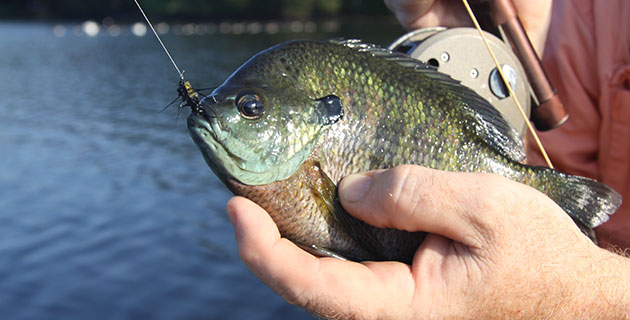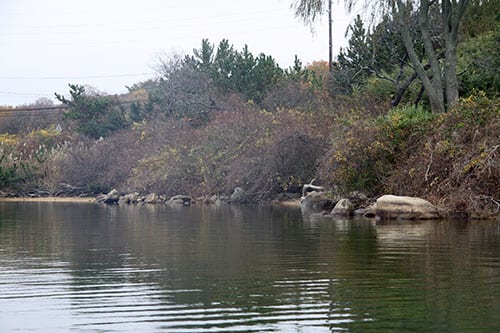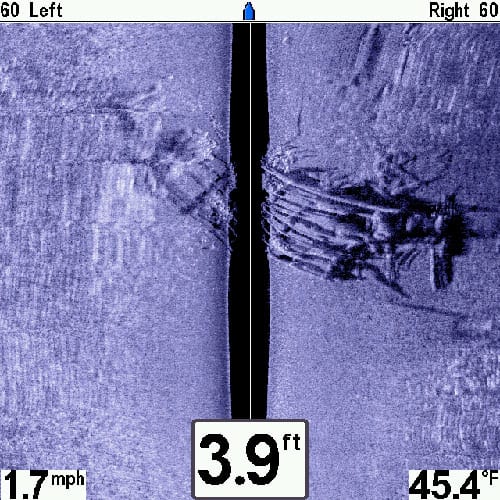
By Tom Schlichter
It’s anyone’s guess how long we’ll have ice on our ponds and lakes this winter, but spring is already just around the preverbal corner and it shouldn’t be more than a few weeks before any ice that is left begins to break apart, at least along the Northeast coast.
Although I still have an itch to get in more hard water action this winter, I also look forward with great anticipation to the period immediately following ice-out because it signals the start of my scouting season. That’s right, I scout before I begin freshwater fishing in earnest each year, and I do it mostly in February for at no time will the water be as gin-clear given a few days without rain.

By now, much of the phytoplankton that robs local waters of their clarity in the late spring and summer months has died off, improving subsurface visibility to the point where on bright, sunny days it may be possible to clearly see bottom in depths exceeding eight feet. That allows for a lot of productive exploring, which I’ll undertake from my kayak, jon boat or even while wading or walking along the shore. I’ll revisit my favorite hot spots and check to see how they’ve changed over the winter, attempt to figure out why some spots produce well and other fishy looking areas don’t, and make special reconnaissance trips to check out the bottom and structure configurations on unfamiliar waters I plan to sample in the season ahead.
You might be surprised to discover how many things can change on a lake over the course of a few years, or even during a single rough winter. Cruise the perimeter of your favorite bass holes, poking into coves and following the contour of prominent points, and you’ll discover new deadfalls, wooden dock posts that have broken free of the shore and settled to the bottom, home-made hockey nets and even discarded Christmas trees.
With the weeds at a low point now, you might also discover some new holes, channel edges and slopes that simply aren’t obvious during the heat of summer. Basically, our lakes and ponds are naked at this time of the year, fully exposed for you to uncover their fish-holding secrets. All you need to do is to get out and start poking around. Get a topo map, or draw one, showing the waters you explore and note on it the specifics of your findings while marking water depth contour lines and possible fishing hot spots. Take the time to record exact positions of any structure you find with a hand-held global positioning device (GPS) or detailed hand-written notes, and don’t pass up the opportunity to pull tight against overhanging brush where you might reclaim a few lures eaten by the shrubbery last summer while finding hidden pockets of deep water beneath shade that may hold lunkers during the August doldrums.

For probing in deeper water where you can’t see the bottom, run a grid pattern while watching your fish-finder or depth recorder to reveal hidden structure, slopes and humps. Be sure to note where sand or mud bottoms border hard or rock bottoms. It’s edges like these that often produce well in early spring and late fall – or even while ice fishing next winter.
Do you enjoy catching spring panfish? If so, one spot you’ll want to keep your eyes out for is the edge that separates shallow flats from deeper channel. Follow these edges whenever you find them, looking specifically for spots where sandy bottom juts out into deeper water or extends to the edge of a channel. These are natural travel routes for bluegills, pumpkinseed and other sunfish to travel as they move from deep water winter hideouts to their shallow spring spawning grounds. Another great panfish setup to watch for is a pocket of three- to five-foot depths close to shore. Oftentimes, the biggest sunnies will pile up here, waiting for the shoreline shallows to heat up enough for a visit to the bank. These pockets can be especially rewarding for shore fishermen and waders to probe in late March and early April.
While exploring new possibilities on the water can be intriguing, there is also a bit of grunt work to be done. Now is the time to check for new posted signs that might reduce your shoreline access if you fish from the bank, make note of parking possibilities and inspect launch sites that may have been updated, removed or – dare I dream it? – improved.
Scouting is best accomplished on calm days with bright sunshine that will penetrate deep into the water, although you can probably glean a good look almost any time the wind lays low. Take your time when poking around and more secrets will reveal themselves than if you rush through the area in an attempt to cover as much ground as possible. Remember that every lake and pond appears different in the winter than it does when surrounded by the lush greens of summer, so be sure to use easily visible shoreline reference points when marking up your maps. Lastly, be sure to wear a good pair of polarized sun glasses on these reconnaissance trips. They’ll help you see deeper into the water, making it easier to pin-point smaller pieces or notice the sharp points and small crevices in larger structure that tend to hold the lunkers.









